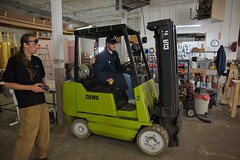A forklift is often the most dangerous piece of equipment used in a manufacturing facility, warehouse, grocery store, or construction site. Although heavy, their small size makes them prone to falling over on uneven surfaces, and their speed can contribute to collisions with people and property. Forklifts are usually operated in areas where there are pedestrians, whom are usually workers. Thus, a majority of forklift accident victims are workers.
Forklifts are used all over the world on construction sites and industrial settings. Each year, forklift truck accidents account for tens of thousands of severe injuries or deaths across the globe. Forklift accidents are usually very serious. Oftentimes, forklift accidents result in leg or foot amputations.
The forklift load often obscures visibility for the forklift operator while going forward. Thus, with a load, forklifts should usually be operated going backwards. Sometimes traveling backwards creates blind spots for the operator whom has to operate the forklift while looking over their shoulder.
Forklifts and OSHA
The Occupational Safety and Health Administration (OSHA) maintain a variety of measures that govern the use of forklifts for companies that fall under federal jurisdiction. Individual states over the years have developed State Occupational Safety and Health Administration plans as well. California OSHA, for example has forklift safety requirements, such as, Cal. Code of Regulations Title 8 CCR
What are the causes of forklift accidents?
1. The forklift tipping over from overloading weight limits.
2. Employees or pedestrians being hit by forklifts.
3. The load falling off of the forklift.
4. Forklifts being used improperly to elevate people - being used as personnel lifts.
5. Forklifts accidentally being driven off loading docks.
6. Forklifts being used with a jib boom. Thus, the forklift is turned into a crane. The load swings and either hits a worker or causes the forklift to tip over.
7. Improper or no forklift maintenance such as malfunctioning of the brakes, steering, transmission, or hydraulic system.
8. Missing or malfunctioning safety devices can contribute to a forklift accident.
9. Lack of a roll over protection system which will prevent the forklift operator from being thrown or crushed in the event the forklift tips over.
10. Improper workplace design for forklift operation such as narrow or crowded aisles, a high level of foot traffic where the forklift is operated, vision obstructions, and other workplace conditions such as light and noise are all hazards that may contribute to a forklift accident.
11. Loss of forklift control by the operator.
12. Traveling too fast and causing the forklift to tip over.
13. Not using a spotter when visibility is limited.
14. Improper training.
Accident Lawyer Bill Turley
has been practicing California Work Injury Law since 1986. He is a forklift lawyer in San Diego. He is a leading San Diego Forklift Accident Attorney. He is a Past President of Consumer Attorneys of San Diego and is on the Board of Governors of the Consumer Attorneys of California. Click here for more free information on San Diego Work Injury Law and San Diego
Forklift Accident Law.
Please be sure and tell us about all the information and posts you find here.

Hi friend,
ReplyDeleteBeautiful blog with nice informational content. This is a really interesting and informative post. Good job! keep it up, hope to read your other updates. Thanks for this nice sharing.
salvia